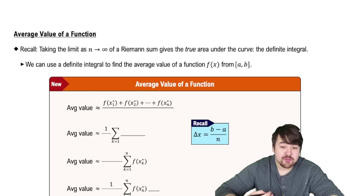Assume that f'(3) = −1, g'(2) = 5, g(2) = 3, and y = f(g(x)). What is y' at x = 2?
Table of contents
- 0. Functions7h 54m
- Introduction to Functions16m
- Piecewise Functions10m
- Properties of Functions9m
- Common Functions1h 8m
- Transformations5m
- Combining Functions27m
- Exponent rules32m
- Exponential Functions28m
- Logarithmic Functions24m
- Properties of Logarithms36m
- Exponential & Logarithmic Equations35m
- Introduction to Trigonometric Functions38m
- Graphs of Trigonometric Functions44m
- Trigonometric Identities47m
- Inverse Trigonometric Functions48m
- 1. Limits and Continuity2h 2m
- 2. Intro to Derivatives1h 33m
- 3. Techniques of Differentiation3h 18m
- 4. Applications of Derivatives2h 38m
- 5. Graphical Applications of Derivatives6h 2m
- 6. Derivatives of Inverse, Exponential, & Logarithmic Functions2h 37m
- 7. Antiderivatives & Indefinite Integrals1h 26m
- 8. Definite Integrals4h 44m
- 9. Graphical Applications of Integrals2h 27m
- 10. Physics Applications of Integrals 3h 16m
- 11. Integrals of Inverse, Exponential, & Logarithmic Functions2h 31m
- 12. Techniques of Integration7h 41m
- 13. Intro to Differential Equations2h 55m
- 14. Sequences & Series5h 36m
- 15. Power Series2h 19m
- 16. Parametric Equations & Polar Coordinates7h 58m
3. Techniques of Differentiation
The Chain Rule
Problem 26
Textbook Question
The number of gallons of water in a tank t minutes after the tank has started to drain is Q(t) = 200(30 - t)². How fast is the water running out at the end of 10 min? What is the average rate at which the water flows out during the first 10 min?
 Verified step by step guidance
Verified step by step guidance1
To find how fast the water is running out at the end of 10 minutes, we need to calculate the derivative of Q(t) with respect to t, which gives us the rate of change of the water volume. This is represented as Q'(t).
First, apply the chain rule to differentiate Q(t) = 200(30 - t)². Let u = 30 - t, then Q(t) = 200u². The derivative of Q with respect to t is Q'(t) = 200 * 2u * (-1), because the derivative of u with respect to t is -1.
Substitute u back into the expression: Q'(t) = 200 * 2(30 - t) * (-1) = -400(30 - t).
Evaluate Q'(t) at t = 10 to find the instantaneous rate of change at that moment: Q'(10) = -400(30 - 10).
To find the average rate at which the water flows out during the first 10 minutes, use the formula for the average rate of change: (Q(10) - Q(0)) / (10 - 0). Calculate Q(10) and Q(0) using the original function Q(t) = 200(30 - t)², then compute the average rate.
 Verified video answer for a similar problem:
Verified video answer for a similar problem:This video solution was recommended by our tutors as helpful for the problem above
Video duration:
6mPlay a video:
Was this helpful?
Key Concepts
Here are the essential concepts you must grasp in order to answer the question correctly.
Derivative
The derivative of a function measures how the function's output changes as its input changes. In this context, the derivative of Q(t) with respect to t gives the rate at which water is draining from the tank at any given time. Calculating the derivative at t = 10 will provide the instantaneous rate of water flow at that moment.
Recommended video:

Derivatives
Average Rate of Change
The average rate of change of a function over an interval is calculated by taking the difference in the function's values at the endpoints of the interval and dividing by the length of the interval. For the first 10 minutes, this concept helps determine the average rate at which water flows out by evaluating Q(t) at t = 0 and t = 10 and dividing the difference by 10.
Recommended video:

Average Value of a Function
Quadratic Function
A quadratic function is a polynomial function of degree two, typically in the form ax² + bx + c. The function Q(t) = 200(30 - t)² is quadratic, and understanding its properties, such as its vertex and symmetry, can help in analyzing how the quantity of water changes over time. This understanding is crucial for calculating derivatives and average rates.
Recommended video:

Introduction to Polynomial Functions

 5:02m
5:02mWatch next
Master Intro to the Chain Rule with a bite sized video explanation from Patrick
Start learningRelated Videos
Related Practice
Textbook Question
